|
Macro by Numbers
Quantitative macro is something of a hybrid. Macro managers do not rely purely on price movements but consider other factors, ranging from inventories to central bank policies. Traditionally they made discretionary decisions not based on computerized models, with George Soros a prime example.
By contrast, a classic trend-follower trades on the basis of price alone, using computer models. Quantitative macro has elements of both.
Paris-based Numbers Alternative Management exemplifies this blend. Here Michel Boiron and Bertrand Savatier, who founded Numbers in 2008, discuss the distinctive approach. Both have a long history in managed futures.
From its launch in February 2008 through December, Numbers' Global Diversified Futures returned 38%. In the first seven months of this year, the Numbers program made almost 6% while managed futures as a group lost money. The program combines global macro quantitative models with technical systems.
Mr. Boiron co-managed a long-term trend-following program from 1996 to 2002, also called Numbers. In 2002, Mr. Boiron went back to trading proprietary capital and exploring new techniques, in particular techniques in discretionary trading. In time he developed computer models that use non-price information and integrate fundamental analysis with systematic trend-following.
Mr. Savatier became director of the managed futures department of BNP Asset Management after running ITF Management, one of the first Swiss CTAs, from 1991 till 1997. In 2000 he co-founded John Locke Investments, a well-known French CTA. In 2006, he sold his shares to his partner and moved to Quantam.
Opalesque Futures Intelligence: How did you manage to make money in the first half of this year, unlike many commodity trading advisors?
Michel Boiron: In the past I worked with a pure trend-following system, but now we have a variety of strategies. Some of them are purely technical and take into account only market action. But others are more complex and integrate either non-price based filters or use a statistical approach that detects short-term anomalies in the distribution of futures spreads. We also use mean-reverting, global macro, currency and interest rate models. Furthermore, we're always looking for new markets and time horizons to extend our portfolio. We currently trade 60 instruments with duration ranging from a few days to over a year. The large variety of different approaches was particularly useful this year.
Bertrand Savatier: The two of us been in systematic trading for a very long time, but the systems we now have are a completely new generation and show very different performance profiles from pure technical systems.
Michel Boiron,"Non-price information, as used by discretionary traders, can be very useful especially in commodity markets."
OFI: What led you to quantitative macro?
MB: Non-price information, as used by discretionary traders, can be very useful especially in commodity markets. I developed discretionary techniques for many commodity futures and over time my discretionary trading became increasingly quantitative. Now those models are fully computerized and blended into a single global program. Because the program contains models with very different analytical underpinnings, it has real diversification.
OFI: How does your approach compare to traditional global macro?
MB: Global macro portfolios tend to be less diversified than ours, because they don't have computerized models and without those it's very difficult to figure out trades in 60 markets at once. By combining computerized global macro models with systematic trend-following in many different markets, we get a much wider diversification than achievable with conventional global macro.
OFI: Where did were the profitable trades this year?
MB: It was not a single trade that made money for us this year. The statistical models and mean-reversion both did well, but there were good trades in other parts of the program, including the non-price indicator screens.
OFI: What non-price information do you include?
MB: That depends on the specific market. For agricultural markets, to take one example, our model may include seasonality.
OFI: How does the rest of the year look for your strategy?
MB: As much as possible, we've designed the program to function in all types of environment. Some of the models do better in some environments, others do better in other environments.
BS: Futures data allows you to back-test your models in very different kinds of environments, like the inflationary 1970s or Japan's deflationary experience since the 1990s. It's a real comfort that we've tested the models against various situations that are similar to what we're likely to face.
OFI: What if commodity markets, in particular energy, go through sharp long trends again?
BS: Our trend-following models will catch those trends. We did very well in the volatile markets of 2008.
| 




 RSS
RSS











